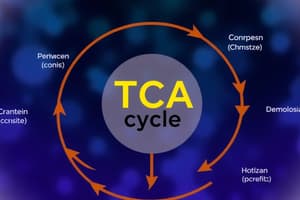Podcast
Questions and Answers
Which enzyme is specifically linked to the irreversible oxidative decarboxylation of isocitrate?
Which enzyme is specifically linked to the irreversible oxidative decarboxylation of isocitrate?
- Lipoic acid synthase
- Alpha-ketoglutarate dehydrogenase
- Isocitrate dehydrogenase (correct)
- Citrate synthase
What effect does an accumulation of pyruvate primarily have in the metabolic pathway discussed?
What effect does an accumulation of pyruvate primarily have in the metabolic pathway discussed?
- Increases production of ADP
- Promotes the synthesis of ATP
- Conversion to lactate (correct)
- Enhances the function of isocitrate dehydrogenase
Which of the following is an inhibitor of the enzymes involved in the oxidation and decarboxylation of isocitrate?
Which of the following is an inhibitor of the enzymes involved in the oxidation and decarboxylation of isocitrate?
- FADH2
- ADP
- NADH (correct)
- Coenzyme A
Which factor is known to activate the enzymes involved in the process of isocitrate oxidation?
Which factor is known to activate the enzymes involved in the process of isocitrate oxidation?
What is a potential consequence of inhibiting lipoic acid-dependent enzymes in the brain?
What is a potential consequence of inhibiting lipoic acid-dependent enzymes in the brain?
Which enzyme is involved in the conversion of succinate to fumarate?
Which enzyme is involved in the conversion of succinate to fumarate?
What is the role of FAD in the oxidation of succinate?
What is the role of FAD in the oxidation of succinate?
What is the significance of succinate dehydrogenase being embedded in the inner mitochondrial membrane?
What is the significance of succinate dehydrogenase being embedded in the inner mitochondrial membrane?
Which compound is produced from the oxidative deamination or transamination of glutamate?
Which compound is produced from the oxidative deamination or transamination of glutamate?
What is the primary product formed when fumarate undergoes hydration?
What is the primary product formed when fumarate undergoes hydration?
What is the most common consequence of pyruvate dehydrogenase deficiency?
What is the most common consequence of pyruvate dehydrogenase deficiency?
How does Fluoroacetate affect the TCA cycle?
How does Fluoroacetate affect the TCA cycle?
What is a potential treatment strategy for symptoms of pyruvate dehydrogenase deficiency?
What is a potential treatment strategy for symptoms of pyruvate dehydrogenase deficiency?
Leigh syndrome is primarily associated with defects in which biochemical pathway?
Leigh syndrome is primarily associated with defects in which biochemical pathway?
What is the mechanism of arsenic poisoning in relation to the TCA cycle?
What is the mechanism of arsenic poisoning in relation to the TCA cycle?
Which of the following is NOT a symptom associated with pyruvate dehydrogenase deficiency?
Which of the following is NOT a symptom associated with pyruvate dehydrogenase deficiency?
Which enzyme is inhibited by fluoroacetate, resulting in citrate accumulation?
Which enzyme is inhibited by fluoroacetate, resulting in citrate accumulation?
Which of the following conditions is a consequence of a mutation in the PDH complex?
Which of the following conditions is a consequence of a mutation in the PDH complex?
What is the role of citrate in the TCA cycle?
What is the role of citrate in the TCA cycle?
Which enzyme catalyzes the conversion of acetyl CoA and oxaloacetate to citrate?
Which enzyme catalyzes the conversion of acetyl CoA and oxaloacetate to citrate?
Which molecule is produced in the oxidative decarboxylation of α-ketoglutarate?
Which molecule is produced in the oxidative decarboxylation of α-ketoglutarate?
What coenzymes are required for the α-ketoglutarate dehydrogenase complex activity?
What coenzymes are required for the α-ketoglutarate dehydrogenase complex activity?
Which bond is cleaved during the synthesis of citrate?
Which bond is cleaved during the synthesis of citrate?
Which of the following is NOT a characteristic of citrate synthase?
Which of the following is NOT a characteristic of citrate synthase?
What is the relationship between GTP and ATP in the TCA cycle?
What is the relationship between GTP and ATP in the TCA cycle?
What is the final product of the TCA cycle's conversion of carbon skeletons?
What is the final product of the TCA cycle's conversion of carbon skeletons?
From where can succinyl CoA be produced?
From where can succinyl CoA be produced?
Which of the following substances acts as an inhibitor of the pyruvate dehydrogenase complex?
Which of the following substances acts as an inhibitor of the pyruvate dehydrogenase complex?
In which cellular organelle does the TCA cycle occur?
In which cellular organelle does the TCA cycle occur?
Which regulatory enzyme phosphorylates and inhibits the E1 component of the pyruvate dehydrogenase complex?
Which regulatory enzyme phosphorylates and inhibits the E1 component of the pyruvate dehydrogenase complex?
What major function does the TCA cycle serve in metabolism?
What major function does the TCA cycle serve in metabolism?
Which compound serves as the final electron acceptor in the TCA cycle pathway?
Which compound serves as the final electron acceptor in the TCA cycle pathway?
What biochemical consequence results from alcohol abuse related to TCA cycle function?
What biochemical consequence results from alcohol abuse related to TCA cycle function?
Which activators indicate that the TCA cycle can proceed by activating the E1 component?
Which activators indicate that the TCA cycle can proceed by activating the E1 component?
What condition occurs when brain cells fail to produce enough ATP due to inactive PDH complex?
What condition occurs when brain cells fail to produce enough ATP due to inactive PDH complex?
How does the TCA cycle relate to the reactions of the electron transport chain?
How does the TCA cycle relate to the reactions of the electron transport chain?
Flashcards are hidden until you start studying
Study Notes
Overview of the TCA Cycle
- Also known as Kreb’s cycle or Citric acid cycle.
- Final metabolic pathway merging carbohydrate, amino acids, and fatty acids metabolism.
- Converts carbon skeletons to CO2 and produces the majority of ATP.
- Occurs in mitochondria, closely linked to electron transport reactions.
- Functions as an aerobic pathway utilizing O2 as the final electron acceptor.
Regulation of the TCA Cycle
- Pyruvate Dehydrogenase (PDH) complex is crucial for TCA cycle regulation.
- PDH complex activation/inhibition occurs through specific enzymes.
- Pyruvate dehydrogenase kinase: Phosphorylates/inhibits E1 (PDH complex), deactivating the cycle; activated by ATP, acetyl CoA, NADH; inhibited by pyruvate.
- Pyruvate dehydrogenase phosphatase: Dephosphorylates/activates E1, allowing the cycle to proceed; activated by calcium, enhancing energy production during muscle contraction.
TCA Cycle Reactions
- Oxidative Decarboxylation of Pyruvate: Pyruvate acts as an end product of aerobic glycolysis, requiring a specific transporter for entry into the cycle.
- Isomerization of Citrate: Citrate converts to isocitrate via aconitase, inhibited by fluoroacetate, leading to citrate accumulation.
- Pyruvate Dehydrogenase Deficiency: Main cause of Congenital Lactic Acidosis, an X-linked dominant disorder, causing neurodegeneration, muscle spasticity, and neonatal death; dietary interventions may alleviate symptoms.
- Leigh Syndrome: Caused by mutations in PDH complex or ATP synthase, leading to subacute necrotizing encephalomyelopathy and progressive neurological deficits.
Specific Steps in TCA Cycle
- Synthesis of Citrate: Acetyl CoA + Oxaloacetate forms citrate, catalyzed by citrate synthase; citrate inhibits citrate synthase and phosphofructokinase while activating acetyl CoA carboxylase.
- Oxidative Decarboxylation of α-Ketoglutarate: α-Ketoglutarate converted to succinyl CoA, yielding 2 CO2 and NADH with coenzymes TPP, lipoic acid, FAD, NAD, and CoA required.
- Oxidation of Succinate: Succinate converts to fumarate via succinate dehydrogenase, which embeds in the inner mitochondrial membrane, functioning also as Complex II of the electron transport chain.
- Hydration of Fumarate: Fumarase catalyzes the conversion of fumarate to L-malate, linking to various metabolic pathways including the urea cycle.
Mechanism of Toxicity
- Arsenic Poisoning: Binds to thiol groups of lipoic acid, impairing enzymatic activity requiring lipoic acid as a coenzyme, leading to pyruvate accumulation and lactate production, affecting neurological functions.
Clinical Conditions Related to TCA Cycle
- Encephalopathy-Psychosis Syndrome: Associated with disruptions in TCA cycle function, potentially from vitamin deficiencies or substance abuse.
- CNS Problems: Brain cells fail to produce adequate ATP when the PDH complex is inactive, underlying neurodevelopmental issues.
Studying That Suits You
Use AI to generate personalized quizzes and flashcards to suit your learning preferences.




